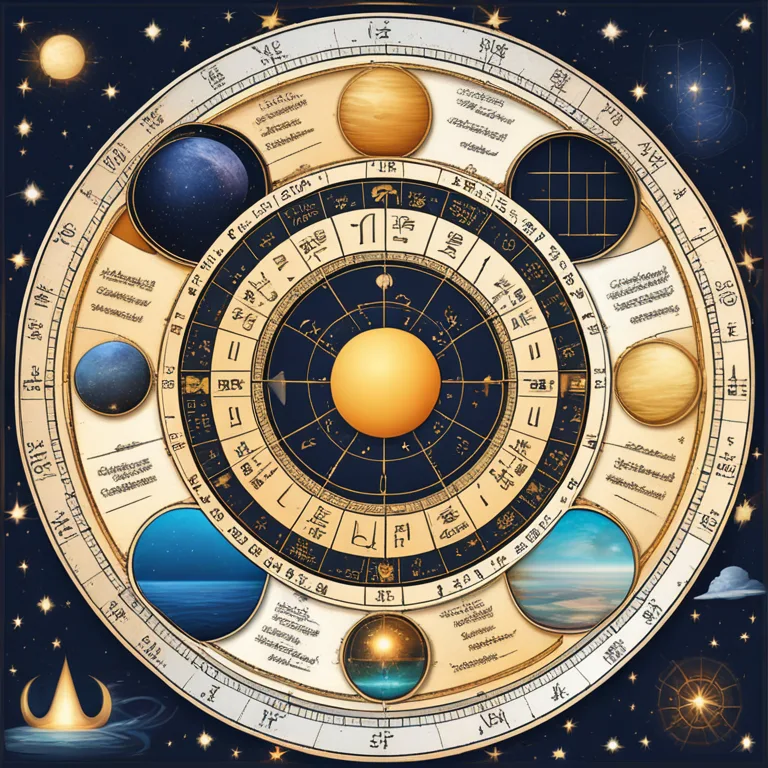
Birth Chart Basics: Exploring The Cosmic Blueprint
Discover the fundamentals of your astrological birth chart and how the celestial bodies influence your personality and destiny.
article by Priya Deshmukh
What Is a Birth Chart?
A birth chart, also known as a natal chart, is a celestial snapshot of the sky at the moment you were born. It is a unique and intricate map that astrologers use to gain insights into your personality, talents, and life path. The chart outlines the positions of the sun, moon, and planets in different zodiac signs, and their interactions form the basis of your individual astrological profile. In essence, a birth chart acts as a cosmic fingerprint that captures your intrinsic traits and potential.

Components of the Birth Chart
There are several key components in a birth chart. The chart is divided into twelve segments known as houses, each representing different aspects of life, from identity to relationships to career. Planets and luminaries like the Sun and Moon carry specific energies and influence the areas governed by the houses they reside in. Zodiac signs, which correlate with the planets, add unique colors to these energies, infusing them with qualities that range from bold and assertive to sensitive and intuitive. Understanding these elements is the first step in interpreting a birth chart.
The Influence of Planets and Signs
Each planet in the solar system affects your birth chart differently, and their significance has evolved over time with astrological practice. For instance, Uranus, Neptune, and Pluto, known as the modern planets, were integrated into astrology after their discoveries and are associated with generational influences. Similarly, the signs of the zodiac add a layer of personality to the planets, deepening the complexity of a reading. As we move into 2024 and beyond, contemporary astrologers continue to study celestial patterns to predict personal and collective shifts.
The Role of the Ascendant
The Ascendant, or rising sign, is another pivotal factor in a birth chart. It signifies the zodiac sign that was ascending on the eastern horizon at the time and place of your birth. The Ascendant shapes your approach to life, dictating the impression you make on others and your spontaneous reactions. It's often considered just as important as your Sun sign in defining your personality. The nature of your Ascendant, informed by current cosmic trends, can offer guidance on how to navigate life's challenges in the coming years.
Synastry and Compatibility
Birth charts don't only serve to illuminate individual traits and fates. When compared to another person's chart, a technique called synastry, you can explore the dynamics of relationships. Compatibility between two charts doesn't solely depend on sun signs but involves a dance of planetary placements and aspects. By examining these connections, astrologers can assess the potential for harmony, conflict, growth, and challenge within any type of relationship, providing insights into the intricate web of human interactions.
Beyond the Natal Chart
Your birth chart provides a foundation, but the story doesn't end there. Progressions and transits, which are movements of planets after your birth, interact with your natal placements, signaling growth, transitions, and critical life events. With the rapid pace of societal changes anticipated in 2024, understanding these movements could prove particularly valuable. They reflect evolving landscapes and personal development, offering a celestial guide for the future.
Published: 12/27/2023
Modified: 12/28/2023
More predictions
Come back here soon to learn more about yourself and your future


Moon Magic in Romance: The Impact of Lunar Phases
Discover how the lunar cycle relates to your love life and partnerships. Learn to interpret the moon's phases for harmony and connection in relationships.


Moon Phase Yoga: Aligning Body & Cosmos
Discover how Moon Phase Yoga harmonizes your practice with lunar cycles for a deeper spiritual and physical connection.


Tracking Moon Phases: A Simple Guide
Learn the easy steps to find out the current phase of the moon with our simple guide, perfect for astrology and horoscope enthusiasts.